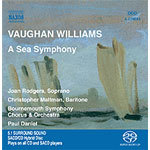
Vaughan Williams - Symphony No. 1, 'A Sea Symphony'
 $28.00
Out of Stock
$28.00
Out of Stock6+ weeks add to cart
VAUGHAN WILLIAMS
Vaughan Williams - Symphony No. 1, 'A Sea Symphony'
Christopher Maltman, baritone / Joan Rodgers, soprano / Bournemouth Symphony Chorus / Bournemouth Symphony Orchestra / Paul Daniel, conductor
[ Naxos SACD / SACD ]
Release Date: Wednesday 1 June 2005
This item is currently out of stock. It may take 6 or more weeks to obtain from when you place your order as this is a specialist product.
"The sound on this disc, in all formats, is excellent, accurately representing the size and depth of the performing group. In the opening phrases the organ pedal notes are clearly differentiated from the timpani rolls, and the words of the chorus are clear"
(MusicWeb Aug 2005)
Hybrid/SACD in 5.1 surround sound. Playable on all compact disc players
"The sound on this disc, in all formats, is excellent, accurately representing the size and depth of the performing group. In the opening phrases the organ pedal notes are clearly differentiated from the timpani rolls, and the words of the chorus are clear"
(MusicWeb Aug 2005)
Several first symphonies have caused their composers much trouble, not least that by Brahms, who laboured for over two decades to bring his C minor Symphony to fruition. The difficulty, in that instance, of furthering an Austro-German symphonic tradition still under the shadow of Beethoven is pertinent when considering A Sea Symphony, the first symphony (though not designated as such) by Ralph Vaughan Williams. When he began it in 1903, the composer was in his early thirties, with a number of songs, chamber works and short orchestral pieces to his name, and little in the way of a national reputation. Completed in 1909, and successfully performed for the first time at the Leeds Festival the following year, the work, together with the Tallis Fantasia, first performed at the Three Choirs Festival only weeks before, confirmed the arrival of Vaughan Williams on the national stage.
Parallel to the composer's evolving of a personal musical idiom went his desire to free English music from the Austro-German framework still prevalent in the music of Parry, Stanford and Elgar. The influence of Parry's choral odes, as well as Stanford's Songs of the Sea and Elgar's Sea Pictures, is intermittently evident, while the latter's The Dream of Gerontius had set a new precedent for a symphonically conceived oratorio, but the combining of high art and folk-inflected music in A Sea Symphony marks a radical departure, while the setting of verses by Walt Whitman (Leaves of Grass in the first three movements, Passage to India in the finale) reinforces the sense of an artistic new dawn such as remained constant in Vaughan Williams' thinking for the next half century.
A choral symphony in the lineage of Mendelssohn rather than Beethoven, the formal construction of A Sea Symphony, with its four movements and sense of tonal closure, nonetheless draws directly on symphonic precedent. The first movement, A Song for all Seas, all Ships, starts with a choral paragraph of breathtaking immediacy, the feeling of new vistas effortlessly evoked. The main part begins with the "rude brief recitative" sung by the baritone in shanty-like strains and enthusiastically echoed by the chorus. Contrast follows with the lyrical "chant for the sailors", rising in intensity until the opening brass fanfare is recalled and the soprano makes a dramatic entrance at "Flaunt out O seas" - marking the onset of the opulent central section. A pensive choral passage centred on the "Tokens of all brave captains" heralds a reprise of the opening music, soloists and chorus in a series of intensifying exchanges which culminate in the reiterated statement "one flag above all the rest". The close, however, recollects the universality of Whitman's message in a mood of tranquillity.
A ruminative calm persists through the second movement, On the Beach at Night alone, a nocturne whose harmonic ambiguity provides a sombre context for this setting entrusted to the baritone. A more robust central section, its main theme warmly set out by horns over pizzicato strings, reaches an affirmative choral climax, before the introspective opening is recalled in largely orchestral terms.
The third movement, The Waves, is a Scherzo which makes considerable demands on the chorus in its contrapuntal intricacy. The work's opening fanfare is recalled, and two folk-songs, The Golden Vanity and The Bold Princess Royal, alluded to in this scintillating depiction of the sea as a natural phenomenon. A noble theme evoking a great sea-going vessel twice provides contrast, before the movement drives to its defiant conclusion.
The Explorers is an apt title for the large-scale fourth movement, a heartfelt summation of the composer's musical and spiritual development. The opening, featuring the words "O vast Rondure swimming in space", sets the exalted tone of much that follows. A modal processional evokes the creation of man, leading to a rarefied setting of "Wherefore unsatisfied soul" and the determined response "Yet soul be sure", together defining the philosophical goal of the whole work. A triumphal culmination is built around the word "singing", the soloists entering impulsively at "O we can wait no longer" to add a more human dimension. The chorus re-enters at "O thou transcendent", then at "Away O Soul" the music irrupts in a frenzy of shanty rhythms as the ship/soul sets sail. Yet the outburst is cut short: the work ending with a calm depiction of the ship vanishing over the horizon, and the implicit journeying of the soul toward those unknown regions on earth as of the human mind.

